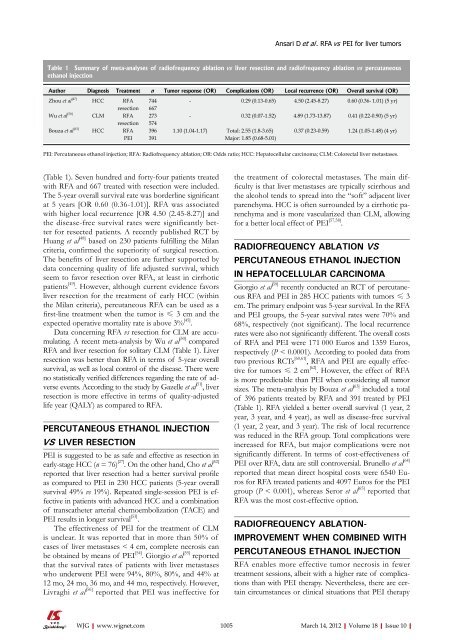10 - World Journal of Gastroenterology
10 - World Journal of Gastroenterology
10 - World Journal of Gastroenterology
Create successful ePaper yourself
Turn your PDF publications into a flip-book with our unique Google optimized e-Paper software.
(Table 1). Seven hundred and forty-four patients treated<br />
with RFA and 667 treated with resection were included.<br />
The 5-year overall survival rate was borderline significant<br />
at 5 years [OR 0.60 (0.36-1.01)]. RFA was associated<br />
with higher local recurrence [OR 4.50 (2.45-8.27)] and<br />
the disease-free survival rates were significantly better<br />
for resected patients. A recently published RCT by<br />
Huang et al [48] based on 230 patients fulfilling the Milan<br />
criteria, confirmed the superiority <strong>of</strong> surgical resection.<br />
The benefits <strong>of</strong> liver resection are further supported by<br />
data concerning quality <strong>of</strong> life adjusted survival, which<br />
seem to favor resection over RFA, at least in cirrhotic<br />
patients [49] . However, although current evidence favors<br />
liver resection for the treatment <strong>of</strong> early HCC (within<br />
the Milan criteria), percutaneous RFA can be used as a<br />
first-line treatment when the tumor is ≤ 3 cm and the<br />
expected operative mortality rate is above 3% [45] .<br />
Data concerning RFA vs resection for CLM are accumulating.<br />
A recent meta-analysis by Wu et al [50] compared<br />
RFA and liver resection for solitary CLM (Table 1). Liver<br />
resection was better than RFA in terms <strong>of</strong> 5-year overall<br />
survival, as well as local control <strong>of</strong> the disease. There were<br />
no statistically verified differences regarding the rate <strong>of</strong> adverse<br />
events. According to the study by Gazelle et al [51] , liver<br />
resection is more effective in terms <strong>of</strong> quality-adjusted<br />
life year (QALY) as compared to RFA.<br />
PERCUTANEOUS ETHANOL INJECTION<br />
VS LIVER RESECTION<br />
PEI is suggested to be as safe and effective as resection in<br />
early-stage HCC (n = 76) [27] . On the other hand, Cho et al [52]<br />
reported that liver resection had a better survival pr<strong>of</strong>ile<br />
as compared to PEI in 230 HCC patients (5-year overall<br />
survival 49% vs 19%). Repeated single-session PEI is effective<br />
in patients with advanced HCC and a combination<br />
<strong>of</strong> transcatheter arterial chemoembolization (TACE) and<br />
PEI results in longer survival [53] .<br />
The effectiveness <strong>of</strong> PEI for the treatment <strong>of</strong> CLM<br />
is unclear. It was reported that in more than 50% <strong>of</strong><br />
cases <strong>of</strong> liver metastases < 4 cm, complete necrosis can<br />
be obtained by means <strong>of</strong> PEI [54] . Giorgio et al [55] reported<br />
that the survival rates <strong>of</strong> patients with liver metastases<br />
who underwent PEI were 94%, 80%, 80%, and 44% at<br />
12 mo, 24 mo, 36 mo, and 44 mo, respectively. However,<br />
Livraghi et al [56] reported that PEI was ineffective for<br />
WJG|www.wjgnet.com<br />
Ansari D et al . RFA vs PEI for liver tumors<br />
Table 1 Summary <strong>of</strong> meta-analyses <strong>of</strong> radi<strong>of</strong>requency ablation vs liver resection and radi<strong>of</strong>requency ablation vs percutaneous<br />
ethanol injection<br />
Author Diagnosis Treatment n Tumor response (OR) Complications (OR) Local recurrence (OR) Overall survival (OR)<br />
Zhou et al [47]<br />
HCC RFA 744 - 0.29 (0.13-0.65) 4.50 (2.45-8.27) 0.60 (0.36- 1.01) (5 yr)<br />
resection 667<br />
Wu et al [50] CLM RFA 273 - 0.32 (0.07-1.52) 4.89 (1.73-13.87) 0.41 (0.22-0.90) (5 yr)<br />
resection 574<br />
Bouza et al [63]<br />
HCC RFA 396 1.<strong>10</strong> (1.04-1.17) Total: 2.55 (1.8-3.65) 0.37 (0.23-0.59) 1.24 (1.05-1.48) (4 yr)<br />
PEI 391 Major: 1.85 (0.68-5.01)<br />
PEI: Percutaneous ethanol injection; RFA: Radi<strong>of</strong>requency ablation; OR: Odds ratio; HCC: Hepatocellular carcinoma; CLM: Colorectal liver metastases.<br />
the treatment <strong>of</strong> colorectal metastases. The main difficulty<br />
is that liver metastases are typically scirrhous and<br />
the alcohol tends to spread into the “s<strong>of</strong>t” adjacent liver<br />
parenchyma. HCC is <strong>of</strong>ten surrounded by a cirrhotic parenchyma<br />
and is more vascularized than CLM, allowing<br />
for a better local effect <strong>of</strong> PEI [57,58] .<br />
RADIOFREQUENCY ABLATION VS<br />
PERCUTANEOUS ETHANOL INJECTION<br />
IN HEPATOCELLULAR CARCINOMA<br />
Giorgio et al [59] recently conducted an RCT <strong>of</strong> percutaneous<br />
RFA and PEI in 285 HCC patients with tumors ≤ 3<br />
cm. The primary endpoint was 5-year survival. In the RFA<br />
and PEI groups, the 5-year survival rates were 70% and<br />
68%, respectively (not significant). The local recurrence<br />
rates were also not significantly different. The overall costs<br />
<strong>of</strong> RFA and PEI were 171 000 Euros and 1359 Euros,<br />
respectively (P < 0.0001). According to pooled data from<br />
two previous RCTs [60,61] , RFA and PEI are equally effective<br />
for tumors ≤ 2 cm [62] . However, the effect <strong>of</strong> RFA<br />
is more predictable than PEI when considering all tumor<br />
sizes. The meta-analysis by Bouza et al [63] included a total<br />
<strong>of</strong> 396 patients treated by RFA and 391 treated by PEI<br />
(Table 1). RFA yielded a better overall survival (1 year, 2<br />
year, 3 year, and 4 year), as well as disease-free survival<br />
(1 year, 2 year, and 3 year). The risk <strong>of</strong> local recurrence<br />
was reduced in the RFA group. Total complications were<br />
increased for RFA, but major complications were not<br />
significantly different. In terms <strong>of</strong> cost-effectiveness <strong>of</strong><br />
PEI over RFA, data are still controversial. Brunello et al [64]<br />
reported that mean direct hospital costs were 6540 Euros<br />
for RFA treated patients and 4097 Euros for the PEI<br />
group (P < 0.001), whereas Seror et al [65] reported that<br />
RFA was the most cost-effective option.<br />
RADIOFREQUENCY ABLATION-<br />
IMPROVEMENT WHEN COMBINED WITH<br />
PERCUTANEOUS ETHANOL INJECTION<br />
RFA enables more effective tumor necrosis in fewer<br />
treatment sessions, albeit with a higher rate <strong>of</strong> complications<br />
than with PEI therapy. Nevertheless, there are certain<br />
circumstances or clinical situations that PEI therapy<br />
<strong>10</strong>05 March 14, 2012|Volume 18|Issue <strong>10</strong>|

















